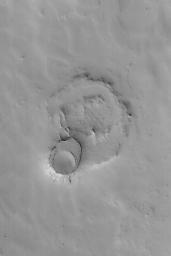
|
Exhuming Crater in Northeast Arabia
- Click the image above for a larger view
- Full-Res JPEG (829 x 1244) (150.2 kB)
- Full-Res TIFF (829 x 1244) (916.7 kB)
Caption:
MGS MOC Release No. MOC2-563, 3 December 2003
The upper crust of Mars is layered, and interbedded with these layers are old, filled and buried meteor impact craters. In a few places on Mars, such as Arabia Terra, erosion has re-exposed some of the filled and buried craters. This October 2003 Mars Global Surveyor (MGS) Mars Orbiter Camera (MOC) image shows an example. The larger circular feature was once a meteor crater. It was filled with sediment, then buried beneath younger rocks. The smaller circular feature is a younger impact crater that formed in the surface above the rocks that buried the large crater. Later, erosion removed all of the material that covered the larger, buried crater, except in the location of the small crater. This pair of martian landforms is located near 17.6°N, 312.8°W. The image covers an area 3 km (1.9 mi) wide and is illuminated from the lower left.
Cataloging Keywords:
| Name | Value | Additional Values |
|---|---|---|
| Target | Mars | |
| System | ||
| Target Type | Planet | |
| Mission | Mars Global Surveyor (MGS) | |
| Instrument Host | Mars Global Surveyor | |
| Host Type | Orbiter | |
| Instrument | Mars Orbiter Camera (MOC) | |
| Detector | ||
| Extra Keywords | Crater, Grayscale, Impact | |
| Acquisition Date | ||
| Release Date | 2003-12-05 | |
| Date in Caption | 2003-12-03 | |
| Image Credit | NASA/JPL/Malin Space Science Systems | |
| Source | photojournal.jpl.nasa.gov/catalog/PIA04904 | |
| Identifier | PIA04904 | |
